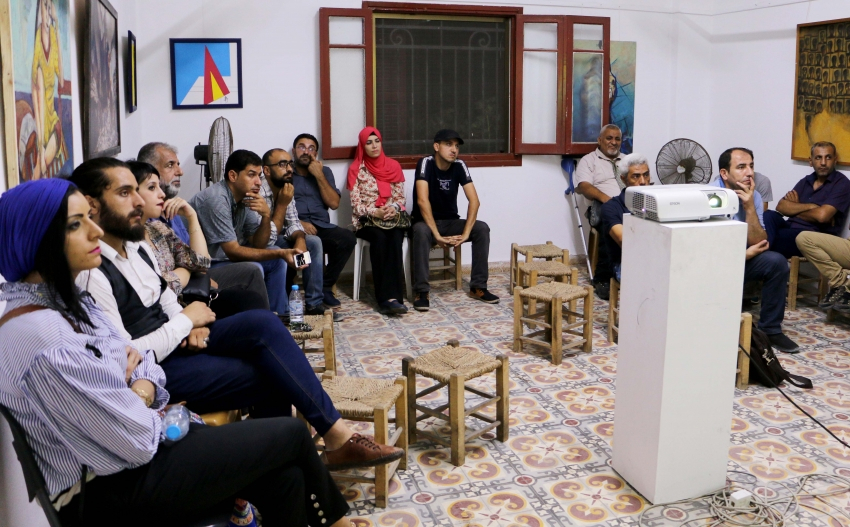

The Public Programme at the A. M. Qattan Foundation, in partnership with the "Visual Arts: A Flourishing Field" (VAFF) project, held an encounter titled A Shifting Landscape. During his trip to Gaza, Yazid Anani, Director of Public Programme, provided a presentation on the role of visual culture in producing visual material in public spaces. Twenty artists and art enthusiasts from the Gaza Strip participated in the encounter.
The interactive encounter took place on the 13 August at Shababeek for Contemporary Art, which assisted in organising the event.
Anani discussed the values of the Palestinian revolution of the 1960s and 1970s represented in Palestinian artwork and now known as ‘Committed Art’. These values include land and the representation of women.
Anani also described how women were represented in Palestinian art in the 1960s, during the height of the feminist movement. According to Anani, women’s representation was important in addressing the global left-wing and shift towards feminist thought.
Later, Anani explained the concept of the shifting landscape, its values and representations by comparing older and contemporary artwork and illustrating how values have changed over time.
“I see a popular adherence to those values because of nostalgia and the absence of collective values. Values changed; however, we’re still holding on to them and their meanings. For example, land is now bound to investments; it was occupied by the Zionist entity and is now seized by investments, which means current generations do not have access to the value of land in its former sense,” Anani explained.
The debate between Anani and the audience revolved around the past and current roles of socially engaged artists.
A question was raised in the debate: “If the artist continues to produce and exhibit commercial artwork in museums and galleries, and if the artist is constantly waiting for funding, what is the role of the socially engaged artist? And how can we find a balance between commercial art and social responsibility free of material gains?”
Anani suggested developing a two-month project in Gaza within the theme of the Ways of Travelling exhibition, to be organised by the Public Programme in 2019. The project includes artists working collectively on a project and producing artwork different from the practice of painting.
“There are clear intersections between our project and the Public Programme which in turn engages with the visual arts within its diverse programme. We believe it is important that the VAFF project partners are exposed to the activities and experiences offered by the Public Programme,” Yara Odeh, VAFF Project Manager, stated.
“The idea of the Shifting Landscape encounter came after VAFF organised a tour of the Subcontracted Nations exhibition with its curator, Yazid Anani, in which our partners from the West Bank participated, but the artists from Gaza were unable to. Therefore, we considered organising an alternative programme with Anani during his visit to Gaza and proposed the idea of the encounter with the artists in Gaza who in turn welcomed the idea,” Odeh added.
“This encounter is useful and important for the contemporary visual art scene, it is an opportunity for artists in Gaza to learn about new contemporary experiences from the West Bank, it is an opportunity to discuss and reflect on contemporary artwork and projects,” Sharif Sarhan, artist and a co-founder of Shababeek, said. “It is also one of the few meetings that take place in Gaza, since it is very difficult to host artists and curators from outside the Gaza Strip because of the siege and closure imposed on Gaza for 12 years now,” Sarhan added.
